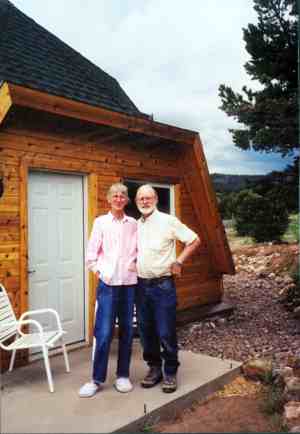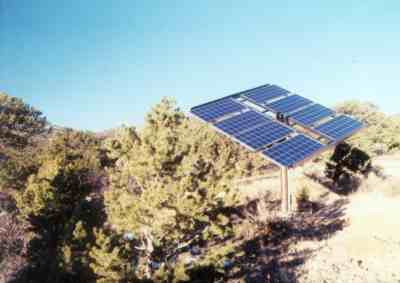Article by Dan Bishop
Energy – December 2002 – Colorado Central Magazine
LAST YEAR, A FRIEND of mine bought 35 acres west of Fort Collins and began building his retirement home. One of the first things he did was contract with the local utility company to bring in power. Then, he paid over $18,000 to have power power lines strung from the nearest pole to his building site, and he also had to remove numerous mature trees along his fenceline to accommodate the new lines. Now that my friend has paid a king’s ransom to be securely linked to the power grid, he can expect to receive a fancy utility bill every month for the rest of his life. He will also be subject to occasional weather-related power outages and possible brownouts through the years.
In contrast, when my wife and I built our retirement home just outside of Saguache, we elected to go “off-grid” with a complete solar photovoltaic (PV) energy system. The total cost for our turn-key system, including full installation and a back-up propane generator, was several thousand dollars less than my friend’s initial outlay. And we have been living quite comfortably in our modern electric home for over a year-and-a-half with solar energy providing virtually all of our electrical needs. Those monthly utility bills are now just a distant memory.
We have calculated that the monthly cost for our system amortized over the thirty-year life of the solar panels is about $65. (This figure takes into account the shorter lifespan and replacement costs for the other components of the system). This is less than many of the utility bills from our previous home. When you take into account the inevitability of utility rate increases over the next thirty years, that $65 per month is a real bargain.

The puzzling thing about my friend’s decision is that we had discussed solar PV energy before he began to build and I fully described our successful experience to him. Months later, when I heard he had chosen to shackle himself to the grid, I called to ask why he had bypassed the solar option. He said he felt intimidated by the intricacies of the system. He also had bought into the official government and big oil company mantra (read “big fat lie”) that the technology is still in its infancy and will not be an effective remedy for our nation’s energy needs for many years to come.
THAT SOLAR PV energy is ready for individual home use has been proven to my satisfaction by my own experience, as well as that of several friends and neighbors here in the San Luis Valley who are also quite happily living off-grid. There now exist numerous small, local businesses that can supply the equipment and install an entire system as a turn-key operation. The home-owner need only know a handful of basic maintenance procedures to keep the system running smoothly. These procedures are no more difficult than checking the oil and tire pressure in your car and are performed only once each month. The fifteen or twenty minutes this requires is a small price to pay to keep the utility company off your back forever.
The real question relating to the viability of solar PV energy has nothing to do with the technology or its availability and practicality. It is simply: “Are YOU ready for solar energy?”
There are many small but significant adjustments in life-style that my wife and I have made in order to make our solar PV energy system work. Most relate to developing good habits of energy conservation — habits that, if adopted by us all, whether on- or off-grid, could produce a noticeable dent in our country’s overall energy consumption.
If you were to visit our 1600-square-foot home, you would be unaware that we are living off-grid. Our entire house is wired quite normally for 110-volt AC electricity with standard outlets everywhere, overhead lights, porch lights, sconce lamps and table lamps. We have a television, computer, microwave and an electric 10.5 cubic-foot refrigerator/freezer. Even our submersible well pump (in a 200-foot well) runs on 110 volts. Eventually we intend to buy an energy-efficient washer and dryer. My workshop includes a compressor, electric drills and table saws. Our entire electrical system feeds out of a breaker box, identical to those you find in any other modern home.
HOWEVER, on closer inspection you would begin to notice some small differences. The first would probably be the lights. We have no incandescent light bulbs in our house. All lighting is done with the new spiral compact fluorescent bulbs. Although they are more expensive than incandescent bulbs, each fluorescent bulb consumes 1/3 the power to produce the same amount of light and is rated to last up to five times longer. If you are truly concerned about energy conservation, you might consider replacing those incandescent bulbs in your own home. And while you’re at it, scale down the illumination in halls, closets, bedrooms and other places where you don’t really need bright light.
The second thing you might notice is that none of our heating appliances use electricity. Electrical energy is a very inefficient source for heat. Furthermore, a typically sized solar PV system cannot handle the tremendous drawdown required by large electrical heating units. Thus our water heater and kitchen range are both gas appliances, and when we add a clothes dryer, it too will be gas operated. Space heating in our home is accomplished with a very efficient wood stove, with propane space heaters as backup. Small kitchen appliances are the single exception. We make good use of our toaster, microwave oven and popcorn popper, all of which are electric.
The fact that we don’t use electricity for heating leads to another less obvious difference in our house. We are not wired for 220-volts. An additional unit in our solar PV system would have allowed us to install 220-volts, but without an electric range or central heating, we decided to forego the additional cost.
We chose our major electric appliances based on their energy efficiency. Our electric refrigerator/ freezer was manufactured in Denmark. It uses less than half the electricity that an American super- efficient refrigerator of the same size requires. Though somewhat smaller than the behemoth we used to own, it serves the two of us quite well. In terms of power consumption, the well pump and refrigerator are the two greatest burdens on our system.
BUT ADOPTING A SOLAR PV system involves more than just changing light bulbs and selecting appliances based on energy efficiency. A serious attitude adjustment is needed as well. For example, in my former life I was terrible about turning lights off when I left a room. When the power comes from a distant, anonymous source with seemingly limitless abundance, we seldom stop to consider the tons of coal, oil or gas, all non-renewable resources, that are being consumed to satisfy flagrant energy consumption. However, when you are producing your own energy in your back yard, energy conservation becomes a way of life. I seldom leave lights on unnecessarily now or flip a switch when there is already adequate illumination for the job at hand.
So-called “phantom users” provide another area ripe for energy conservation. These are appliances that consume electricity even when they are not being used. Examples include electric clocks, VCRs, and microwave ovens. Assuming my best “ghost buster” mode, I fabricated shortened extension cords with built-in toggle switches to use with these appliances. We can now turn off all power to these appliances when we are not using them. Since this won’t work with clocks, all of our clocks are battery operated.
Besides making a special effort at energy conservation, we have also learned to be aware of efficient energy management. For example, vacuum sweepers, irons, saws and compressors, washers and driers are heavy energy users. It only makes good sense to schedule their operation whenever possible during a bright sunny day. This gives the batteries a break. You too can adopt this conservation practice by checking with your utility company to learn what hours in the day and days in the week they experience their lowest demand and scheduling your high energy use activities during those periods. This lessens their “peak load” requirements and ultimately reduces the number and/or size of power plants needed.
We also try not to schedule two energy-intensive tasks for the same period. With a little communication my wife and I avoid overlapping vacuuming with extensive use of workshop tools. As a further accommodation to energy management, our refrigerator outlet is wired through a wall switch, allowing us to temporarily turn the refrigerator off when we are using a tool or appliance with a heavy energy draw. Of course, we have to remember to turn the refrigerator back on!

WHAT ABOUT MAINTENANCE of a solar PV system? There are four simple tasks that need to be done periodically.
1. I run the backup propane generator once each month for several hours. This serves two purposes. First, it “equalizes” the batteries and recharges them to full charge, a requirement for battery longevity. Second, it keeps the generator engine lubricated and provides a periodic test to ensure that it is functioning.
2. Several days after equalizing the batteries (step 1 above), I check the water level in each cell and add distilled water to any cells that are low. This takes between 10 and 20 minutes, depending on how many cells need water.
3. After a snow I use a broom to brush off the solar panels so they can do their stuff.
4. Four times each year, we adjust the angle of the solar panel mount so the panels are aimed more directly at the sun. This merely involves removing two bolts, moving the mount to the new position, and reattaching the bolts. It takes about five minutes.
How large a solar PV system should be depends upon the particular circumstances of a household. How large is your family? What adjustments are you willing or unwilling to make? I know of one individual who installed a second solar PV system just so he could have an electric kitchen range.
We have eight 120-watt solar PV panels on a solar tracking mount. This provides a maximum of 960 watts of DC electricity that is fed into a controller/inverter unit. During the day, the controller/inverter converts the solar generated DC electricity to 110-volt AC for house use and recharges our bank of twelve deep-cycle batteries in our garage. At night and on cloudy days, the batteries provide the DC electricity to the inverter which converts it to 110-volt AC for house use. The switchover from solar panels to batteries and back again is entirely automatic.
The 110-volt AC electricity from the inverter is fed directly into our breaker panel. Our inverter and backup generator are matched to provide the breaker panel with a total of 35 amps. And believe it or not, that is quite sufficient. (Remember, we have an energy efficient refrigerator, fluorescent lighting, etc., with no electrical heating appliances, and we practice careful energy management. Most new homes are set up for 150 or 200 amp service.)
Although our system cost roughly $16,000 installed in 2000, prices for some items have gone down. You could duplicate our system today for about $14,000. If you are building a new home, this cost could be included in your construction costs and amortized over the life of your loan.
Would I recommend solar energy for every home? As much as I would like to say “yes,” I must qualify my response.
Solar works well for us because we live in Central Colorado where there are very few cloudy days. This past year, for example, there were only two periods where skies were overcast for three consecutive days. (And we didn’t “run out” of electricity even then.) You would probably need a larger solar array and more batteries to provide electricity where cloudy days are frequent.
Another positive factor working for us is the location of our house. Knowing that we would be “off-grid” and dependent on solar energy, we bought property with an unobstructed southern exposure that was relatively clear of hills or large trees in both east and west directions. This maximizes both our views of the valley and the hours of direct sunlight our panels receive each day throughout the year. If you have unalterable obstructions that would block direct sunlight on your panels for part of each day, you would have to compensate with a larger system.
IF YOU ARE ALREADY CONNECTED to an electrical utility, you might consider a “grid-intertie” system. The cost is less because you can eliminate the batteries and the back-up generator. The utility company becomes your source of power for nighttime usage and cloudy days. But during sunny days you generate enough solar PV energy to maintain your independence and possibly to sell some of that electricity back to the utility company (at their “wholesale” rates, which are far below what they charge you).
A recent development in solar PV cells is a flexible cell that can be used as a substitute for traditional roofing materials. If your house or garage has a sloping roof that faces toward the south, you can cover that side of your roof with such solar cells. Although they won’t track the sun, they are considerably less conspicuous than equipment mounted on a pole. If you’re building from scratch or replacing an older roof, this alternative might be an attractive choice — and part of the expense of solar cells can be gleaned from what you save by not shingling your roof.
In conclusion, if you truly desire to cut your electricity bills over the next several years, you should adopt an energy conservation mindset. Become aware of your energy usage and develop habits of conservation. Then begin replacing energy consumptive appliances — and lighting and heating — with energy efficient alternatives.
Finally, when you have taken these steps, consider installing a solar PV system. Once installed, that system should require very little attention, and it will give you “free” electricity for decades.
Dan Bishop attempts to practice sustainable living with his wife, Ann, on their “dome-stead” just east of Saguache where he gathers inspiration from the panoramic views of the San Luis Valley and the ever-changing cloud formations over the Sangre de Cristo mountains.

The solar connection here is that this is a picture of their Christmas branch of 2001. Shortly before Christmas, they noticed that, with the sun lower in the sky, one large branch on a tree south of their solar panels was shading the panels in the afternoon. So they cut the branch off and used part of it for the Christmas tree that year. As you can see from the photo, even though they are off the grid, they still aren’t restricted from using Christmas tree lights (although they are incandescent) for celebrating the holidays.

